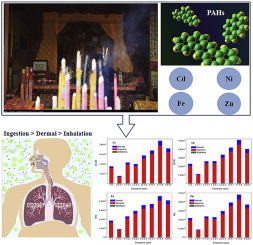Environmental Pollution ( IF 7.6 ) Pub Date : 2018-02-13 , DOI: 10.1016/j.envpol.2017.10.107 Lulu Cui , Bu Duo , Fei Zhang , Chunlin Li , Hongbo Fu , Jianmin Chen

|
This paper presents a detailed study on the indoor air pollution in the Jokahng Temple at Tibet Plateau, and its implication to human health. The mean concentrations of PM1.0 and PM2.5 were 435.0 ± 309.5 and 483.0 ± 284.9 μg/m3, respectively. The PM2.5 concentration exceeded the National Ambient Air Quality Standard (75 μg/m3) by 6.4 times. The size-segregated aerosols displayed a bimodal distribution. One peak was observed in the fine mode (0.4–2.1 μm) and the other peak appeared in the coarse mode (2.1–9.0 μm). The concentration of the total size-resolved PM was 794.3 ± 84.9 μg/m3. The mass fraction of coarse particles shared by 41.1%, apparently higher than that reported at low altitudes, probably due to incomplete combustion at Tibet Plateau with hypoxic atmospheric environment. The total concentration of polycyclic aromatic hydrocarbons (PAHs) was 331.2 ± 60.3 ng/m3, in which the concentration of benzo(a)pyrene (BaP) was 18.5 ± 4.3 ng/m3, over ten times higher than the maximum permissible risk value of 1 ng/m3 on account of carcinogenic potency of particulate PAHs through inhalation. PAHs exhibited a trimodal distribution, of which two peaks were observed in the fine mode and one peak in the coarse mode. With the aromatic rings increasing, the peak intensity increased in the fine mode. Na, Ca, Al, Mg and K dominated the elemental mass profiles, and metals displayed a bimodal distribution with a dominant peak in the coarse range. The total PAH deposition flux was 123.6 and 53.1 ng/h for adults and children, respectively. Coarse particles contributed most deposition flux in the head region, while fine particles contribute most deposition flux in the alveolar region. The increment lifetime cancer risk (ILCR) of PAHs ranaged at 10−5-10−4, indicating potential cancer risk to human health. The total deposition flux of metals was estimated at 1.4–13.2 ng/h. With the size increasing, deposition flux increased in the head region while decreased in the alveolar region. The highest ILCR of Cr and Ni were 4.9 × 10−5 and 1.5 × 10−6, respectively, exceeding the permissible risk of 10−6. The hazard quotient (HQ) of Fe (10−5-10−4) and Zn (10−6-10−5) were much lower than the safe level of 1.0, and thus they were not considered as a health concern.









































 京公网安备 11010802027423号
京公网安备 11010802027423号